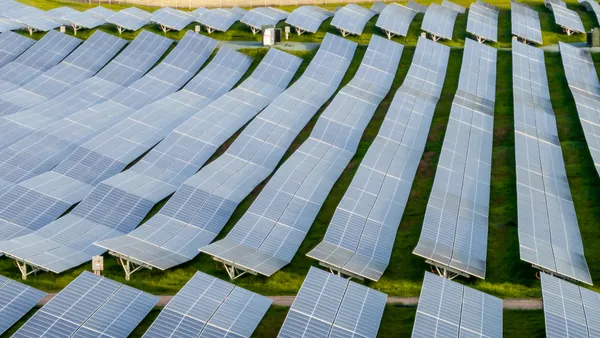In the old days, if utility operators wanted to tap the advantages of a thin film, utility-scale photovoltaic system they needed to allow for more land as compared to using crystalline silicon-based panels. But those days are over.
“Today, our efficiency meets or exceeds our multi-crystalline peers,” says Nicholas Strevel, Senior Manager for Module Technology at First Solar, based in Perrysburg, Ohio. “This allows developers to install more capacity on less land with thin film modules.”
Overall costs for using solar continue to fall due to declining equipment prices and rising efficiency ratings. Surviving the solar financial shakeup of a few years ago, First Solar has remained a stable and bankable manufacturer of high efficiency thin film PV.
To back up his claim, Strevel touts the leader board of all things solar, the National Renewable Energy Laboratory’s (NREL) cell efficiency chart. The multi-colored, line graph depicts solar energy’s slow, methodical march toward achieving ever-higher efficiency ratings.
“First Solar’s thin film recently hit a 22.1% cell efficiency according to NREL, which is a world record,” says Strevel, “To put the numbers in perspective, we were sitting on 16% four years ago.”
This NREL chart measures best research cells in a laboratory, where small area cells are a good future predictor of larger, full module entitlement. Silicon-based cells and others that rate in the 20s in the lab usually have a module efficiency of around 16 at large-scale manufacturing.
Using the knowledge gleaned in the lab to manufacture and replicate products presents another pricey problem. Five years ago, First Solar started pumping R&D money into their preferred solar technology based on cadmium telluride, (CdTe), which according to the U.S. Department of Energy (DOE) is “the second most abundant photovoltaic technology in the world marketplace.” The DOE says, “CdTe thin film solar cells can be manufactured quickly and inexpensively, providing a lower-cost alternative to conventional silicon-based technologies.[i] Most experts agree that silicon based systems have technologically topped out while CdTe still has plenty of headroom to grow.
CdTe technology has been around since the 1950s but has traditionally played David to the Goliath of crystalline silicon. Higher efficiency ratings kept Goliath on top of the hill but investing in the future is showing good returns.
“We are a younger technology, and doing R&D on younger technologies can be costly and time consuming,” says Strevel. First Solar has spent over $600 million over the past five years in research and development to help develop the future of thin film. A collaboration with GE provided First Solar with a parcel of non-overlapping technologies that helped change the cell efficiency game.
“It was not a single thing that we did to advance the efficiency rating,” says Strevel. “It wasn’t like we just changed the recipe, it was a combination of looking at the basic science, the manufacturing process and then moving it to large-scale manufacturing.”
While many firms playing in the solar arena farm out facets of the manufacturing process, First Solar prefers to keep things under one roof. “We control the manufacturing process from start to finish,” says Lou Trippel, Senior Director of Product Management at First Solar. “We’re assembling the systems in a totally controlled environment which allows us to monitor and control all facets of the manufacturing components and process, ensuring a consistent high-quality product which turns into a cost advantage for our customers.”
While it is common for traditional crystalline silicon module manufacturers to engage in “tolling” (which is putting their brand name on modules partially or entirely manufactured by various sub-contractors), First Solar has charted a different course. By maintaining a fully integrated in-house manufacturing approach, First Solar has been able to provide more transparency to its customers and is able to achieve better reliability and consistency for its modules.
The business philosophy appears to be paying off as the firm continues to see its modules outperforming crystalline silicon modules in independent reliability and energy performance benchmarking studies.
“Our current financial strength significantly differentiates us from our competitors and enables us to innovate more rapidly,” says Trippel. “If a large portion of your revenues is going to service debt, you don’t have as much money to do the research that you need to do to stay competitive or to invest in rigorous quality testing to demonstrate long-term predictable reliability.”
Staying competitive in solar means plotting another dot on the NREL chart. Strevel says, “We believe that continuous efficiency improvements for our technology are within direct reach and we believe those achievements will translate into industry leading modules and power plants for years to come.”
[i] “Cadmium Telluride,” Energy.gov, http://energy.gov/eere/sunshot/cadmium-telluride










